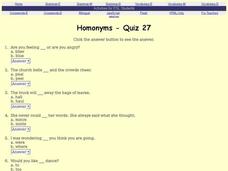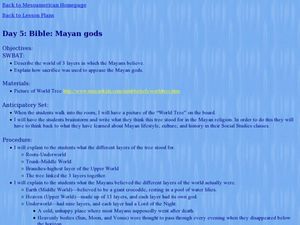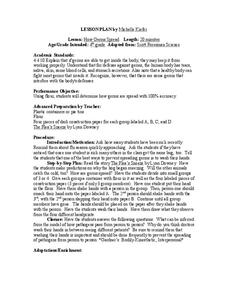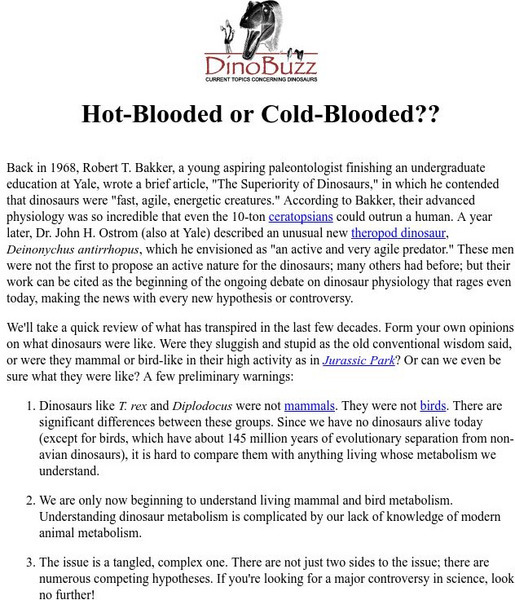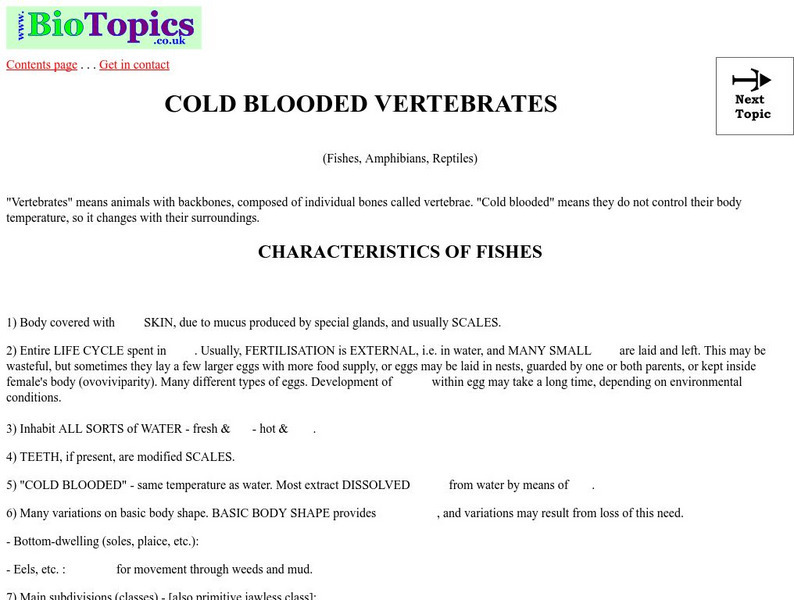Curated OER
Habitat Hopscotch
Students analyze different habitats. In this habitat lesson, students evaluate what animals need in their habitats. Students participate in the game Habitat Hopscotch.
Curated OER
Related Rates Problems: An Application of Implicit Differentiation and the Chain Rule
For this related rates problem worksheet, students use the chain rule and implicit differentiation to solve related rate problems, such an writing an expression relating to the ripple of a circle. This three-page worksheet contains...
Curated OER
Baleen Whales vs. Toothed Whales
Second graders review mammal characteristics and study two types of whales. In this mammal study lesson, 2nd graders discuss mammals and define their five characteristics. Students complete a whale worksheet and define differences...
Curated OER
How Germs Spread
Students conduct a test to help them visualize the spread of
germs. They identify that a pandemic is an epidemic (an outbreak of an infectious disease) that spreads across a large region or even worldwide. Finally, students state...
Curated OER
ESOL Safety and Security
Students review a list of vocabulary words needed in emergency procedures at home and work. They discuss safety procedures for each work emergency; choking, Heart Attack, and Chemical burn.
Curated OER
Genes and Inheritance
Students explore genes and inheritance. After listening to a story describing a rare genetic disease, students discuss inheritance and how living things pass on traits to their children. In groups students, students decipher code...
Curated OER
Beaver Ecology
Students explore the lives of bgeahvers. They identify the physical and behavioral adaptations that help beavers survive in their environment. Students compare and contrast how beavers influence the ecology of both forest and aquatic...
Curated OER
Animal Behavior: "Groggy Goldfish"
Students observe goldfish in different environments. In this biology lesson plan, students watch the behavior of goldfish in water of varying temperatures.
Curated OER
Homonyms - Quiz 27
In this online interactive ESL worksheet, students respond to 20 fill in the blank questions regarding homonyms. Students may submit their answers to be scored.
Curated OER
Biology Quiz
For this biology worksheet, students complete short answer questions about botany, animals, plants, DNA, and more. Students complete 15 short answer questions.
Curated OER
Health
In this health instructional activity, students choose the correct word to complete the sentences about health. Students complete 15 multiple choice questions.
Curated OER
Bible: Mayan Gods
Students discover beliefs and practices of the Mayans. In this Mayan gods lesson, students discuss "The World Tree" of the Mayans, the three layers of the tree, and their meanings. Students discover the manner and purpose of...
Curated OER
Introduction to the Panpipe
Students examine the panpipe and the cultures that use them in their music. They view photos of Peru and Bolivia and discuss their cultures, listen to recordings of music that includes the panpipe, and construct a panpipe using PVC...
Curated OER
How Germs Spread
Fourth graders investigate how germs spread in this lesson. They listen to "The Flea's Sneeze" by Lynn Downey and make predictions on why the hog began sneezing. They then conduct an experiment using flour and paper cups demonstrating...
Curated OER
Go With the Flow!
Students experiment with heat transfer in a countercurrent system and describe the importance of conduction in heat-energy transfer.
Curated OER
All About Ducks for Kids
In this duck facts worksheet, students read series of paragraphs from on online website about ducks. Students may then complete several related duck activities.
Curated OER
Coma
Students examine the diving reflex response which allows a person to stay underwater for an extended period of time. They complete an experiment to compare resting pulse rate and pulse rate when their face is submerged in water.
Scholastic
Scholastic News: Were Dinosaurs Warm or Cold Blooded?
Scientists have never known if dinosaurs should be called warm-blooded or cold-blooded animals. Learn about the surprising new discovery that has shed light on the answer to this question.
University of California
Ucmp: Hot Blooded or Cold Blooded?
An easy-to-understand explanation of what it means to either hot- or cold-blooded.
Bio Topics
Bio Topics: Cold Blooded Vertebrates
A worksheet regarding cold blooded vertebrates, including fishes, reptiles and amphibians.
California Institute of Technology
Infrared Zoo Lesson 3: The Invisible Zoo
How do biologists and zoologists use infrared technology to learn how warm and cold-blooded animals thermoregulate their internal body temperature? Have your students explore this phenomenon using this great lesson plan.
Environmental Education for Kids
Eek!: Reptiles
Discover all you can about the various species of cold-blooded vertebrates, otherwise known as reptiles.
Bill Nye
Bill Nye: Temperature Time Warp
This tutorial by Bill Nye explains why cold-blooded creatures need a warm environment to survive.
A&E Television
History.com: The Mariel Boatlift: How Cold War Politics Drove Thousands of Cubans to Florida in 1980
After Fidel Castro loosened emigration policies, some 125,000 Cubans landed on U.S. shores over a span of five months. The Mariel Boatlift of 1980 was a mass emigration of Cubans to the United States. The exodus was driven by a stagnant...
Other popular searches
- Cold Blooded Animals
- Cold Blooded Animals
- Warm Blooded Cold Blooded
- Warm and Cold Blooded Animals
- Cold Blooded Vertebrates
- Warm Blooded Cold Blooded
- Are Dinosaurs Cold Blooded
- Warm Cold Blooded
- Cold Blooded Reptiles
- Mammals and Cold Blooded
- Cold Blooded Respiration
- Warm Blooded, Cold Blooded








